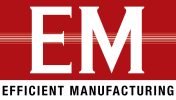
Author: Dipalee Singh
| In the aftermath of the FAME II Policy’s release, Electronic Vehicles’ (EV) adoption in India has further increased due to the Battery Swapping Technology. Kaushik Burman, General Manager, Gogoro India India, one of the world’s largest automobile markets, has accelerated its journey toward net-zero carbon emissions and embraced the clean energy transition with remarkable resilience, reaching an inflection point. The Government of India, along with its key ministries of Heavy Industries, Consumer Affairs and Finance, aided by National think tanks, has collectively laid impetus to the decarbonisation goals with gusto, creating a manifest in the success of the FAME-II policy…
| Operational excellence, which involves maximising value and minimising inefficiencies, has become a top priority for manufacturing companies. To achieve this, many companies have turned to lean manufacturing, a robust methodology that optimises manufacturing processes, createsefficient workflows, reduces lead times, increases productivity, improves quality and ultimately enhances customer satisfaction. The advent of technology and its application in advanced analytics has brought about a paradigm shift in manufacturing. Technology has become reliable for consistently achieving value creation and process efficiency goals. Manufacturing companies are embracingtechnology across all facets of their operations, from forecasting and planning to resourcing, utilisation, operations management, cash…
| Battery swapping in e-mobility is a fast-growing trend and is of particular use in specific applications in the segment. The two most popular use cases where swapping has been of particular interest are e-rickshaws and commercial two-wheelers. Both of these cases demand a high daily run in terms of kilometres travelled, and in both cases, the vehicle is used to earn a livelihood. Hasan AliCo-FounderEsmito What about the economic viability of the model, both for the end user and for the energy operator? For the end user, the cost is in terms of the daily or monthly cost of…
| E-mobility, the burgeoning industry in India, has experienced a remarkable surge in recent years, rendering it a highly promising field with an array of potential prospects for businesses and individuals alike. Anmol Bohre, Co – Founder and Managing Director, Enigma EV The potential of electric vehicles to emit significantly fewer pollutants than ICE vehicles can help reduce greenhouse gas emissions that contribute to climate change. Lower emission rates can subsequently improve the air quality index as well as promote public health. Notably, the industry has enormous economic potential, including the creation of employment opportunities and augmenting investment prospects. Projections put forth…
| Industrial automation mainly aims to reduce the necessity of people in manufacturing processes. This allows production to speed up, increase safety and better utilise their resources and industrial analytics in manufacturing. Let’s look into a detailed overview of how Dinesh Chand Sharma, Co-chair, Standards, Regulatory and Legal Working GroupIET Future Tech Panel Automation Goals for IndustriesThe Internet of Things (IoT) describes a phenomenon where more and more IoT devices are connected to the Internet. It has deeply penetrated all aspects of our lives, businesses and industries, such as smart homes, smart fridges, meters, cities and industrial manufacturing. The terms “digital manufacturing”,…
| India’s automotive components manufacturing industry is projected to grow significantly in the global auto supply chains. Local companies are anticipated to experience a rapid growth in market share in the upcoming years. The auto component manufacturing industry serves as a vital sector that not only fuels the growth of the global automotive industry but also plays a pivotal role in driving macroeconomic growth, development and generating substantial employment opportunities. Additionally, the industry has witnessed remarkable growth in the demand for auto components globally, further reinforcing its importance and impact. Importance of the Industry Currently, the overall Indian auto components industry…
| Driven by the advancements in digital technologies, IT–OT integration has established a robust environment from field devices to platform-independent cloud solutions. A&D discusses how plug-and-play and cloud-neutral solutions resolve interoperability challenges in Industry 4.0. Praveen Kumar Vijay Narayan Singh,Chief OPC Solution Architect, Connectivity Solutions,Utthunga Cybersecurity, data connectivity, interoperability, remote monitoring and maintenance and management information systems (MIS) have become crucial in large-scale enterprise businesses. The most valuable outcome of the IT–OT convergence is the paradigm shift from reactive maintenance to proactive maintenance while creating new business opportunities. This shift has led to the much-needed advancement in almost every aspect mentioned…
| Die and mould are responsible for shaping plastic material to the desired design and shape of the toy. They ensure that the toy is manufactured in large quantities with consistency and precision. A read on… Gaurav Mirchandani, Founder & CEO, SM Toys The die and mould industry plays a crucial role in the manufacturing of toys in India. Die and moulds are specialised tools used in the production of toys, allowing manufacturers to create toys with consistent shapes, sizes, and intricate details. Most of the items for sale in toy aisles across the nation are made of plastic, as can be seen…
| By 2030, nearly one in three vehicles in India will be electric, and one in ten EVs sold worldwide will be in India. However, the Indian EV industry is still in its early stages. Specialised service providers can help them increase the efficiency of their production and reach the next level of technology and collaboration. Sudhir Gurtoo, Managing Director,Leadec India Dr Christoph Jaschinski, SVP Global Business Development,Leadec Group Decreasing battery costs The costs of a battery system account for the largest share of the manufacturing costs of a vehicle, up to 30–40 percent of total manufacturing costs. This is a…
| As the manufacturing industry goes, so goes the future. Perhaps no other industry has seen a greater impact from technological advancements than manufacturing. And this is particularly true today, as automation driven by Artificial Intelligence (AI) and Machine Learning (ML) is once again sending shockwaves through the industry. Sudeep George, Vice President Engineering, iMerit As the world is experiencing yet another Industrial Revolution driven by advancements in AI and ML, it is critical that the Indian manufacturing industry keep pace with technological change. It was in 2015 when the Government of India launched its Digital India initiative to empower India…










